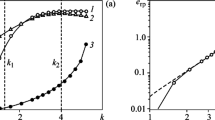Abstract
We analyze the applicability of a modified Leonov-Panasyuk-Dugdale model to the description of the propagation of a mode I crack in structured materials under plane stress conditions. For quasi-brittle materials, refined formulas of the critical length of the prefracture zone and the critical load containing a structural parameter are proposed. The Kornev model is extended to the case of quasi-ductile materials. Numerical simulation of plastic zones in square plates of a bimetal and a homogeneous material under quasi-static loading is performed. In the numerical model, the equations of deformable solid mechanics are expressed in the Lagrangian formulation, which is the most preferred for large-strain deformations of elastoplastic materials. The results of the numerical experiments are consistent with the results of calculations using the analytical model for the fracture of structured materials.
Similar content being viewed by others
References
N. Eaton, A. Glover, and J. McGrath, “Features of Fracture in the Manufacture and Operation of Welded Structures,” in Fracture Mechanics. Fracture of Structures (Mir, Moscow, 1980), Issue 20, pp. 92–120.
D. M. Lipkin, G. E. Beltz, and D. R. Clarke, “A Model of Cleavage Fracture along Metal/Ceramic Interfaces,” Mater. Res. Soc. Symp. Proc. 436, 91–96 (1997).
D. Broek, Elementary Engineering Fracture Mechanics (Springer, 1982).
S. V. Suknev, “The Use of Nonlocal and Gradient Criteria to Evaluate the Fracture of Geomaterials in Regions of Tensile Stress Concentration,” Fiz. Mezomekh. 14(2), 67–75 (2011).
S. Usami, H. Kimoto, I. Takanashi, and S. Shida, “Strength of Ceramic Materials Containing Small Flaws,” Eng. Fract. Mech. 23(4), 745–761 (1986).
Yun-Jae Kim and Karl-Heinz Schwalbe, “Mismatch Effect on Plastic Yield Loads in Idealised Weldments. 2. Heat Affected Zone Cracks,” Eng. Fract. Mech. 68, 183–199 (2001).
V. M. Kornev, “Generalized Sufficient Strength Criteria. Description of the Prefracture Zone,” Prikl. Mekh. Tekh. Fiz. 43(5), 153–161 (2002) [J. Appl. Mech. Tech. Phys. 43 (5), 763–769 (2002)].
V. M. Kornev, “Stress Distribution and Crack Opening in the Prefracture Zone (Neuber-Novozhilov Approach),” Fiz. Mezomekh. 7(3), 53–62 (2004).
V. M. Kornev and N. S. Astapov, “Model of the Fracture of a Piecewise Homogeneous Medium for Layering of Elastoplastic Structured Materials,” Mekh. Kompoz. Mater. Konstr. 16(3), 347–360 (2010).
V. D. Kurguzov, V. M. Kornev, and N. S. Astapov, “Fracture Model for Bimaterials in Layering. Numerical Experiment,” Mekh. Kompoz. Mater. Konstr. 17(4), 462–473 (2011).
A. G. Demeshkin, V. M. Kornev, and N. S. Astapov, “Strength of a Laminated Composite in the Presence of Crack-Like Defects,” Mekh. Kompoz. Mater. Konstr. 19(3), 445–458 (2013).
V. D. Kurguzov and V. M. Kornev, “Construction of Quasi-Brittle and Quasi-Ductile Fracture Diagrams Based on Necessary and Sufficient Criteria,” Prikl. Mekh. Tekh. Fiz. 54(1), 179–194 (2013) [J. Appl. Mech. Tech. Phys. 54 (1), 156–169 (2013)].
I. M. Kershtein, V. D. Klyushnikov, E. V. Lomakin, and S. A. Shesterikov, Based on Experimental Fracture Mechanics (Moscow State Univ., Moscow, 1989) [in Russian].
V. M. Kornev and A. G. Demeshkin, “Quasi-Brittle Fracture Diagram of Structured Bodies in the Presence of Edge Cracks,” Prikl. Mekh. Tekh. Fiz. 52(6), 152–164 (2011) [J. Appl. Mech. Tech. Phys. 52 (6), 975–985 (2011)].
Yu. G. Yanovskii, Nanomechanics and Strength of Composite Materials (Institute of Applied Mechanics of the Russian Academy of Sciences, Moscow, 2008) [in Russian].
Author information
Authors and Affiliations
Corresponding author
Additional information
Original Russian Text © V.D. Kurguzov, N.S. Astapov, I.S. Astapov.
__________
Translated from Prikladnaya Mekhanika i Tekhnicheskaya Fizika, Vol. 55, No. 6, pp. 173–185, November–December, 2014.
Rights and permissions
About this article
Cite this article
Kurguzov, V.D., Astapov, N.S. & Astapov, I.S. Fracture model for structured quasibrittle materials. J Appl Mech Tech Phy 55, 1055–1065 (2014). https://doi.org/10.1134/S0021894414060182
Received:
Revised:
Published:
Issue Date:
DOI: https://doi.org/10.1134/S0021894414060182




